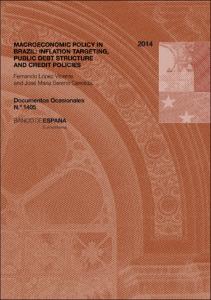Macroeconomic policy in Brazil : inflation targeting, public debt structure and credit policies
Authors
Issue Date
9-Oct-2014
Physical description
30 p. : gráf., tab.
Abstract
La conducción de las políticas macroeconómicas experimentó importantes cambios en América Latina a finales de los noventa. Brasil es un ejemplo notable de aquellos, al introducirse el objetivo de inflación como marco de política monetaria en 1999, y un nuevo marco fiscal en 2000, con la ley de responsabilidad fiscal. Sin embargo, hay dos elementos que en la práctica restringieron este marco de política macroeconómica: la composición de la deuda pública y la estructura del sistema bancario. Este trabajo expone la importancia que tuvieron estos factores y cómo han evolucionado de modo distinto desde entonces. La estructura de la deuda pública, caracterizada por la indexación, el corto plazo de los vencimientos y una posición corta en dólares, supuso una importante restricción a las políticas macroeconómicas durante la década del 2000. Sin embargo, estos problemas fueron superados de modo gradual, y la composición de la deuda pública no se deterioró tras la crisis financiera global. El segundo factor relevante era la estructura del sistema bancario, que se caracterizaba por la segmentación y los elevados márgenes de los intereses de préstamos sobre depósitos. Estos elementos han persistido, y se han convertido en elementos clave para entender los desarrollos macroeconómicos actuales, la política crediticia y el tono de la política monetaria
Macroeconomic policy in Latin America underwent significant changes in the late nineties. Brazil is an outstanding example: inflation targeting was introduced in 1999 and a new fiscal policy framework was set up in 2000 with the Fiscal Responsibility Law. However, two elements of the Brazilian economy constrained the apparently state-of-the-art macroeconomic policy framework: the composition of public debt and the structure of the banking system. This paper discusses why macroeconomic policies were restricted by those factors and how they have evolved differently. The structure of public debt, characterised by indexation, short-term maturities and short US dollar positions, imposed significant constraints on macroeconomic policies during the 2000s. Nevertheless, these vulnerabilities were gradually overcome and the composition of public debt has remained stable in the aftermath of the global financial crisis. At the same time, the structure of the banking system was characterised by credit segmentation and high interest spreads, and these characteristics are still present today. These features have become key elements in understanding current macroeconomic developments, credit dynamics and the economic policy stance
Macroeconomic policy in Latin America underwent significant changes in the late nineties. Brazil is an outstanding example: inflation targeting was introduced in 1999 and a new fiscal policy framework was set up in 2000 with the Fiscal Responsibility Law. However, two elements of the Brazilian economy constrained the apparently state-of-the-art macroeconomic policy framework: the composition of public debt and the structure of the banking system. This paper discusses why macroeconomic policies were restricted by those factors and how they have evolved differently. The structure of public debt, characterised by indexation, short-term maturities and short US dollar positions, imposed significant constraints on macroeconomic policies during the 2000s. Nevertheless, these vulnerabilities were gradually overcome and the composition of public debt has remained stable in the aftermath of the global financial crisis. At the same time, the structure of the banking system was characterised by credit segmentation and high interest spreads, and these characteristics are still present today. These features have become key elements in understanding current macroeconomic developments, credit dynamics and the economic policy stance
Notes
Incluye referencias bibliográficas
Publish on
Documentos Ocasionales / Banco de España, 1405
Subjects
Deuda pública; Banca central; Políticas crediticias; Public debt; Central banking; Credit policies; Bancos centrales y otras autoridades monetarias; Política monetaria; Mercados de valores; Brasil
Appears in Collections:












